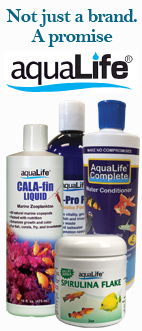|
|
Product Detail
|
|
|
 |
| Item#: |
SC1076 |
|
|
|

| Type Use: |
|
| Units/Case: |
1 |
| Wt Each: |
3.65 |
|
|

|
|
|
 |
|
|
|
|
|
| Product Name: |
Reef Buffer 250g
|
|
| Category: |
Additives* |
|
| Subcategory: |
pH, gH, & kH |
|
| Manufacturer: |
Seachem |
|
|
|
|
Reef Buffer will also raise carbonate alkalinity; however, it is intended primarily for use as a buffer in a reef system where the maintenance of a pH of 8.3 is often difficult. When pH is not an issue, Reef Builder or Reef Carbonate should be your first choice for a carbonate alkalinity supplement.
Reef Buffer is specifically designed to meet the needs and requirements of the closed reef environment. The principal difference between Reef Buffer and Marine Buffer is that the pK of Reef Buffer is slightly higher than that of Marine Buffer. The pK of a buffering agent is equivalent to the pH around which that buffer most strongly buffers. One would presume, then, that the pK of a saltwater buffer should be 8.3; however, the multitude of organic acids produced by the inhabitants of a reef system forces pH downward to a much greater degree than in a non-reef, marine system. A buffer with a pK of 8.3 would end up yielding a pH more in the range of 8.0-8.2. Reef Buffer's higher pK (8.6) allows for greater pH stability in a reef system where the bioload is significantly more than in a fish only system.
Why It's Different
Competing products are not designed specifically for the reef environment; the pK is too low (in most cases, pK 8.3). At this pK, the proper pH can never be reached in saltwater. Reef Buffer's higher pK (8.6) allows for greater pH stability in a reef system where the bioload is significantly more than in a fish only system.
Directions
Check pH and alkalinity before use. Use 5 g (1 level teaspoon) for every 150 L (40 gallons) to raise pH by about 0.1 pH units (this will also raise alkalinity by about 0.5 meq/L). Dissolve in at least one cup of freshwater, then add to the tank. The pH of natural sea water is 8.25Ã8.30. In a well established reef system pH adjustment may be necessary biweekly to semiweekly. Dosing requirements will vary, but do not exceed the recommended dose without checking your pH and alkalinity (alkalinity should not exceed 6 meq/L). If an alkalinity of 6 meq/L has been reached and a pH of at least 8.20 has not been attained or substantial cloudiness that does not clear within 15 minutes is encountered, then the system is not ionically balanced. To restore ionic balance perform a water change or adjust the magnesium and calcium levels to approximately 3:1 Mg:Ca (calcium does not need to exceed 400 mg/L).
DO NOT OVERDOSE: Excess alkalinity may enhance the loss of calcium, magnesium, and strontium. Do not directly mix with any calcium, magnesium, or strontium supplement. |
|
|
|
|
|


